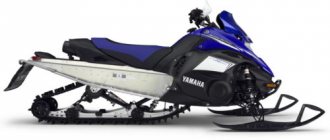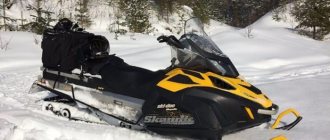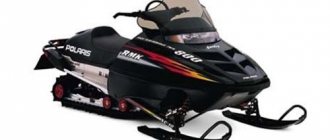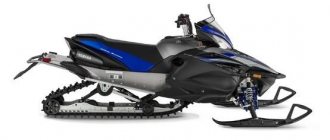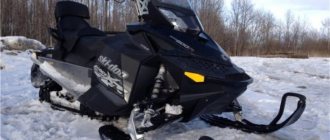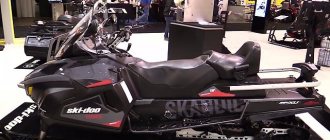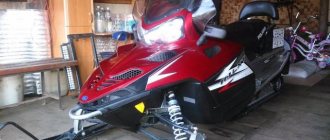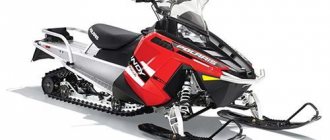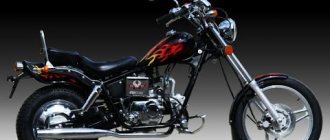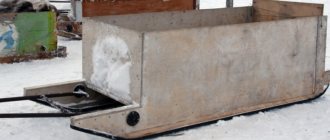FX Nytro MTX SE162: stylish and aggressive mountain snowmobile
The Yamaha Nitro snowmobile (Snowbike Yamaha FX Nytro) is a series of Japanese snowbikes with four-stroke three-cylinder engines with a displacement of 1049 cm3 and a net power of up to 175 horsepower (according to the manufacturer).
The first snowmobile of this model rolled off the assembly line in 2007, and then modernized versions of the snowmobile were regularly produced, both with minor changes in appearance and with tuning of entire components of the snowmobile. Yamaha's 2014 Nytro MTX comes in 153cm and 162cm tracks. The wide lip of the Snow Moto MT-9 provides good stability and controllability of the snowmobile, which is especially necessary when traveling in deep snow. According to owner reviews, the Nitro 162 model with a Camoplast Ascent track is more suitable for long mountain climbs, and the 153 model with a Camoplast Maverick transmission is less powerful, but benefits from its lighter weight.
Mountain model “Yamaha FX Nytro M-TX SE 162”
Yamaha has given fans of snowmobiles an excellent gift - the new FX Nytro M-TX SE 162, whose profession is to overcome deep snow. This mountain model has a four-stroke, three-cylinder engine, gas-filled shock absorbers, and its main weapon is a long caterpillar with exposed teeth to match the piranha.
... A COUPLE of days ago, while riding a snowmobile with a short “fast” track, I fell into a ditch of absolutely terrible depth and width, completely covered with snow. Ask me what I dreamed about while digging a tunnel with my hands, through which a subway train could easily be launched after me? About a snowmobile of the “Mountain” type, that is, a mountain one. Just like the new Yamaha. And here in front of me is the same ditch.
In the old days, soldiers went on the attack to the sound of a march. The beautifully colored exhaust sound from the solid muffler, peeking out like a motorcycle from under the seat of the “FX Nytro M-TX SE 162”, sounds no less impressive - of course, for those who understand. To this victorious music, the snowmobile plunged into the treacherous hole up to the very footrests and, pushing a huge pile of snow with its short snout, floated out to the other “shore” easily and simply, without even sneezing even once. That's it, know ours.
Yamaha FX Nytro Specifications
The Yamaha Nytro snowmobile has left its competitors far behind. What will surprise the car in technical terms?
Parameters of the Nytro snowmobile, released in 2014:
- Camoplast2 Rip Saw tracks that prevent the machine from getting buried in the snow. The track, 381 mm wide, allows you to pass the most difficult sections of the mountain route.
- Four-stroke engine Yamaha Genesis 130FI with liquid cooling. Engine power – 130 hp.
- Electric starter.
- CVT transmission.
- YVXC clutch.
- Hydraulic disc brake.
- Dual Shock rear suspension with two gas shock absorbers.
- Front suspension with HPG shock absorber.
- Fuel tank volume – 27.7 l. For 100 km, a powerful car consumes approximately 15-20 liters of gasoline, depending on the route.
- Aluminum frame.
- Plastic body.
The basic version of the Yamaha Nitro has anti-slip coating and protection for: hands, belt, exhaust pipe, clutch, headlights.
Test drive YamahaFX Nytro X-TX
The competition between snowmobile manufacturers has become so fierce that the engineers of these companies are literally bending over backwards to organize a small technical revolution for the next new season.
The main “revolutionaries” of the 2009 season in the Yamaha snowmobile family are the FX Nytro X-TX crossover and the extreme “tourist” RS Venture GT. The FX Nytro X-TX device is a modification of the FX Nytro sports model series. Since their introduction in 2007, there has been one big complaint about Nytro cars - they desperately resist active control and strive to throw the rider off their “scruff” in almost every turn. Only experienced and physically strong riders could stay in the Nytro saddle at a fast pace. But even they complained about the oversteer characteristic of these “snowballs”. It is logical that in 2009, not only the new X-TX modification, but the entire FX Nytro model range received an improved front suspension.
In total, about thirteen changes were made to the front suspension design. The geometry of the horizontal and vertical arms has changed, due to which the center of the contact surface of each ski has moved forward. The angle of inclination of the front pillar has become sharper, which significantly facilitates the steering process in turns and has a positive effect on the overall stability of the vehicle at high speed. The distance between the skis has decreased slightly - from 1056 mm to 1053 mm, and their toe angle has changed from 22° to 25.8°. Like this! Somewhere a couple of millimeters is a minus, and somewhere a few degrees is a plus. Yamaha engineers, like sculptors, brought the design of the front suspension to technical perfection. However, it is known that there is no place for perfection in our world. But it was the seemingly insignificant (seemingly) design changes to the front suspension that made the FX Nytro series vehicles more controllable and friendlier towards their pilots.
Depending on the modification, FX Nytro snowmobiles are equipped with different shock absorbers. For example, on the thoroughbred R-TX SE, the front suspension is equipped with advanced Fox FLOAT-X Front shock absorbers. In the FX Nytro X-TX crossover model, the front shock absorbers are a little simpler - adjustable GYTR. However, simpler does not mean worse. After all, the FX Nytro X-TX is not an ordinary sports “lighter”, intended purely for high-speed “produbas” on a cross-country “comb”. The main “revolutionary” element in the Nytro X-TX is the rear suspension, which allows you not only to quickly “dust” along a prepared track, but also not be afraid to go out into loose snow. It is clear that there is a limit to everything. But if in order to “bury” a utility vehicle with a track 50 cm wide you need to show dexterity and experience, then in order to “bury” a sports unit up to the headlight in “powder”, no special talent is required. Just popped in - hello, take out a shovel and do some fitness in the fresh air.
The secret of the “revolutionary” versatility of the FX Nytro X-TX is that due to the 6-degree rise of the rear part of the guide rails of the Dual Shock CK 144 suspension, the track forms a different contact patch depending on the snow surface. The overall length of the track is 144 inches (3 m 65.7 cm). When driving on hard snow, the track operates like a short 121-inch (3 m 7.3 cm) sport track. On the cross-country track, the FX Nytro X-TX feels no worse than its purebred sports brothers in the model range. The snowmobile sensitively reacts to the pilot’s movements with its body, “tucks” into sharp turns without any problems, and is not afraid of springboard jumps. And don’t forget – a small contact patch opens up the opportunity to increase speed.
Once the FX Nytro X-TX hits a chaotically rough, snow-covered country track, the load on the track increases along its length to 136 inches (3 m 45 cm). The snowmobile has increased traction properties while maintaining stability and without significant losses in controllability and speed. According to the “full program” and to its full “growth”, the caterpillar begins to work on loose snow. The level of cross-country ability of the FX Nytro X-TX is hardly correct to compare with utilitarian cars, but for some “tourists” in the virgin snow, the Yamaha crossover will easily be a worthy competitor. Just don’t get too carried away with “loitering” in the deep “powder”. After all, the Genesis engine with a power of 130 “mares” in the X-TX is tuned for sports and speed, and not for pulling a dozen shot down wild boars out of a ravine. You should not expect trolleybus traction at low speeds from a high-speed engine. Well, if you make a mistake and over-gas while in a white field, dig, Shura, dig. Don’t leave equipment worth 406,000 rubles to the mercy of fate.
Especially for those who don’t smile at tapping out the “saber dance” with their teeth and only sometimes have the desire to “stick” the throttle all the way, Yamaha has prepared a new “tourist” model – the RS Venture GT. The 2009 model year RS Venture is radically different from its predecessors. Firstly, the three-cylinder 120-horsepower Genesis 120FI has undergone significant modernization. Despite the remaining “cubic capacity” of 1050 cm3, compared to the RS Venture engine of the 2008 model, the new power plant is one kilogram lighter, 5% more economical and 6 hp. more powerful.
Accordingly, the torque has increased in value, especially at low speeds. The second distinctive point is that the RS Venture is built on the new, progressive, second-generation Deltabox platform, which guarantees a comfortable fit and easy, predictable control. Contrary to its touring status, the RS Venture GT is capable of “burning” the track not only along a straight line. In my opinion, the RS Venture GT is not exactly a “tourist”; it would be more correct to say that it is a sports-touring class snowmobile. By the way, the external design of the device is designed in a sports-motorcycle style. Judge for yourself: the exhaust pipes are a la the Yamaha R1 sportbike; the rear trunk lid (volume 28 liters) is clearly copied from a sports car; the seat (with adjustable lumbar support) with its shape clearly hints at its close relationship with car seats. And all this beauty is offered to customers at a price of 410,000 rubles. Among competitors, the conversation about highly comfortable “tourists” in the basic configuration starts at 450,000 rubles.
Sports installation
Genesis 130FI – coasting
The Nytro X-TX model is equipped with a 4-stroke 3-cylinder Yamaha Genesis 130FI engine with a displacement of 1050 cm3. The engine was designed specifically for participation in snowcross competitions. In principle, it would not be difficult for Yamaha engineers to create a motor with a larger cubic capacity, but the ISR (International Snowmobile Racing) rules do not allow snowmobiles equipped with an engine with a displacement above 1050 cm3 to compete.
The Genesis 130FI became the first power plant on which Yamaha tested its Engine Braking Reduction System (EBRS) in professional racing conditions, created to minimize the effect of engine braking, so typical of 4-stroke engines. 2-stroke engines do not have this problem, which allows for better control of the snowmobile when coasting.
The main element of EBRS is the ISC (Idle Speed Control) air valve, which is electronically controlled and located in the intake manifold. The ISC valve changes the throttle valve settings, thereby controlling engine idle speed, bypassing the standard engine management system. When the engine is running at high speeds and the driver suddenly releases the throttle, the EBRS system allows a certain amount of air through the ISC valve and the engine is allowed to “breathe” bypassing the closed throttle valve - the engine braking effect is significantly neutralized. Although it was still not possible to completely overcome it.
Text: Automobiles Magazine
Digital dashboard.
The illuminated digits on the FX Nytro M-TXSE162 snowmobile's instrument panel display all key information. The speed of the snowmobile is displayed on a wide LCD display in both miles and kilometers per hour. In addition, the second screen, at the driver's discretion, can display tachometer, odometer (distance traveled) or round-trip mileage data. The panel also has indicator lights for fuel level and engine overheating, so the driver can easily monitor the operation of all snowmobile systems.
Comparison of Yamaha FX Nytro with competitors and analogues
Yamaha produces reliable and relatively inexpensive equipment. But despite this, Japanese snowmobiles have more than enough competitors. The main opponents are BRP, Arctic Cat and Polaris.
The competition for the Yamaha snowmobile was: Polaris Switchback Pro R 800, Arctic Cat XF 800 and Ski-Doo Renegade E-TEC 800. All machines are in the same price category and practically do not differ in technical characteristics. The only difference is power. The working volume of the Japanese is 1049 cubic meters. cm, and the same Canadian has only 799.5 cc.
There is competition within the company as well. The Yamaha Nitro snowmobile performs well not only in extreme conditions, but also on the track. The series is a worthy competitor to the Venture line of travel devices. At the same time, cars for driving in the mountains are much cheaper than tourists. The price of Ventura models ranges from 1.1 to 1.3 million rubles, and Nitro costs from 420 to 800 thousand rubles.
Yes, indeed, there is much more virgin snow in our country than well-groomed paths, where sports (read: fashionable in our country) models are at ease, and the one who thinks that in a machine for deep snow you will not get either an adrenaline drive or a thrill from "Grips". The mind-buster - FX Nytro M-TX. And it’s not just about wide skis and an unrealistically long track with huge “oars” - grousers: the machine’s trump card is its original concept, which implies absolute maneuverability in snow of any depth.
About technology and more
THE FIRST models of the “Nytro” line, presented by Yamaha several years ago, surprised with a very unusual design. There was not the slightest hint of a front fairing, the engine was located behind the front suspension, closer to the middle of the snowmobile, and the suspension itself seemed to originate directly from the headlight. The new snowmobile looks even more unusual - its second generation “FX Nytro” front suspension is like no other. There is no visible power element or springs. Instead, there are gas-filled shock absorbers from the famous Fox Float company. Rear – “Fox Float 2” of increased volume. The shock absorbers are adjustable to suit the track and driving style.
The genesis of the three-cylinder Genesis 130F1 engine with Mikuni multiport fuel injection and three heated throttle valves, each 41 mm in diameter, goes back to the legendary liter four-cylinder engine that was on the Yamaha R1 sports bike. The calling card of a four-stroke Yamaha engine is traditionally five-valve heads, with three intake valves and two exhaust valves. Having lost one cylinder during the evolution, but maintaining a working volume of 1,049 cubic meters. cm, the engine gained in weight, dimensions, and most importantly – in low-end traction.
Well, the most important thing about the “FX Nytro M-TX SE 162” is the already mentioned wide and long (38.1x411.5 cm) “Camoplast Maverick” track. It has a low angle of attack - only 18 degrees - for better maneuverability in deep snow. And the huge 5.7-centimeter spikes give the caterpillar a truly terrifying look.
If you ever have to choose between a four-stroke and a two-stroke snowmobile engine, I advise you to go for the four-stroke, although for the same displacement it will have less power than a two-stroke. But he has other trump cards, and impressive traction at low speeds is just one of them. In addition, it is simpler and, if you like, more pleasant to use: there is no need for unpleasant fuss with constant topping up of oil for two-stroke engines, which causes burnout, and strict control over its level (God forbid you mess up - and the end of the engine). A four-stroke engine needs an oil change only once a year. And I won’t say anything about the environment - every “green” person will tell you that a four-stroke engine is less harmful to the atmosphere.
Features and operation of the Nitro snowmobile
Yamaha's development has been appreciated by millions of fans of speed and extreme riding. The car performs well on the highway, in the mountains and on rough terrain. Of course, the owners are a little upset about the carrying capacity of the device; you can’t ride a snowmobile together, but this is not a touring model.
- Reliable and powerful Genesis engine, with a volume of 130 cc (base model) and 135 (XTX unit).
- High speed and maneuverability. The cruising speed of the car is 100 km/h.
- Low fuel consumption. Considering the engine power, the snowmobile is very economical.
The manufacturer did their best and made the Nitro a universal snowmobile. The only drawback is the price of original spare parts.
Yamaha Nytro MTX 162 Turbo
Manufacturers of equipment with which you can confidently drive through snowy expanses are constantly improving their designs. In order for the rider to get the maximum level of pleasure from winter trips on snow, researchers and testers are constantly working on new models of snowmobiles. This is what happened with the well-known snowmobile Nytro MTX 162 from the manufacturer Yamaha, which was released back in 2012. This was a fairly powerful snowmobile even without improvements, but the designers decided to install a turbine on it. Thanks to its installation, engine power increased from 130 to 179 horsepower. This improvement will help riders get even more adrenaline from extreme snowmobiling. This heavy-duty all-terrain vehicle is strong enough to overcome any route.
To purchase a model with a turbine, you must order a basic model, and the official dealer will complete its configuration. The fact is that this model does not come off the assembly line. Ordering a turbine and installing it will not be cheap. The cost of a turbine installed on a Yamaha MTX exceeds five thousand conventional units, which is by no means cheap. To comply with international environmental standards, an afterburner must also be installed on the model. The turbine kit is installed at the rear. The turbine inlet is located next to the exhaust pipe.
If we talk about the handling of this snowmobile model, it should be noted that it largely depends not so much on the skis, but on the masterful qualities of the driver. This snowmobile is very powerful and difficult to handle, especially at high speeds. The key to success when driving is the correct distribution of weight by the rider. Snowmobile driving skills help you overcome skids and make incredible turns in untouched spaces.
This model has a number of pleasant little things that will surprise and bring pleasure to even the most demanding fans of extreme snowmobiling. These include heated handlebar grips, a reclining seat and perforated footrests. After a long drive through snowdrifts, snow does not stick to them. This snowmobile, like every motorcycle or snowmobile, has its drawbacks. Disadvantages include its close location to the front chassis body. After overcoming a deep snowdrift, the device often shovels snow with its belly, which is very annoying for the rider.
Polaris 800 RMK 155 model 2015 || Arctic Cat XF 8000 High Country
Related posts:
New from Yamaha snowmobile Viper L-TX DX 2015In the section: Snowmobile newsAll other things being equal, if we had to choose between the 2015 Yamaha Viper L-TX DX and its Arctic Cat copycat, we would choose the Yamaha snowmobile. | Polaris presented the new RZR XP Turbo 2022 ATVIn the section: ATV newsPolaris showed the new RZR XP Turbo 2022 ATV |
Stage II of the Open off-road quad series Can-Am X Race 2017In the section: Competitions and eventsFrom July 26 to 29, Yoshkar-Ola will host the second stage of the Can-Am X Race 2017 off-road quad race. | Side-by-Side all-terrain vehicles. Polaris RZR XP 1000 in comparisonIn the section: UTV newsHow can BRP and Polaris compete? Of course, muscles, power and capabilities. |
Test drive of the Polaris Turbo IQ LXT touring snowmobileIn the section: Snowmobile newsThe new product is positioned by the company as a successor to the Fusion model. A few years ago, the latter was called the standard of a tourist snowmobile. | BMW S1000RR Turbo – unbridled power!In the section: TuningHeavy-duty bikes are becoming increasingly common on the civilian market. Almost any motorcycle enthusiast, if he has the necessary funds, can acquire a real sports monster. |
Lightweight CF die-cast FX frame.
Integrating the chain guard into the chassis structure is one of the benefits of Yamaha's exclusive Controlled Flowdiecasting technology. By reducing the size of small air bubbles in the metal during the casting process, Yamaha engineers were able to cast thinner-walled and more complex, feature-rich components, allowing the chain housing to be cast directly into the snowmobile frame.
Model/modification history
Since 1996, Yamaha has produced the sports YZF1000R Thunderace, which formed the basis of the YZF R1. The distinctive features are: an inverted fork, an updated frame, and the latest generation Genesis engine. As a result, the rider received lighter hardware, a more powerful engine, efficient handling and improved ergonomics. The configuration was “tailored” for the track, but among ordinary people it also won many fans. The plastic was available in blue and red and white.
Interest in the “YuZF” (as it is called in the CIS) does not subside even today. The company continues to improve the bike, fueling demand.
How about self-development and improvement of the Yamaha YZF R1?
2000 – first restyling
